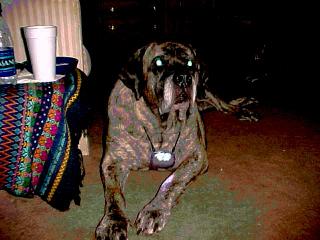
strung around the neck of those without hands.
For about the last twenty-five hours, tropical force (and near-tropical force) winds whistled over and through Pensacola Beach and nearby areas. It's too early to assess the damage. Darkness has fallen now, anyway. All that can be done for the moment is give a highly personal, impressionistic picture of what this day was like for Pensacola... Gulf Breeze.... Navarre Beach... and other nearby coastal communities.
Most everyone knew Hurricane Katrina was going to miss Northwest Florida by a couple of hundred miles. Yet, we knew the prognosticators might be wrong and that, in any event, they said we'd probably experience tropical force winds for a few hours. The people one met standing in line at the store, or waiting for gas at the few stations that still had any fuel, all knew the drill. They were ready, we were ready. For anything. Or so we thought.
But, a very, very large tropical storm, even one that merely grazes your area, is harder to endure than many imagined. You are cooped up without power for hours and hours on end while winds whistle outside the door, mysterious things go bump-bump on the roof, rain squalls of fine needle-like droplets rattle the windows, and the mid-day skies turn as dusky as late evening.
Of course, we had flashlights in hand -- or strung around the neck of those without hands. And there was Scrabble or Yahtzee to be played by the oldsters, and Gameboys for the youngun's. But ceaseless tedium and anxiety take their toll. Dogs snap at each other. People snap at each other. People snap at dogs.
Interestingly, dogs don't snap at people. As Roald Amundsen knew intutively, and Robert Scott did not know to his everlasting regret, the company of dogs makes even the terrible tribulations of an Antarctic winter -- and now we can say, Gulf hurricanes, too -- bearable for human beings.
Weather news was easier to come by during this storm than ever before, even when the power went out. This is thanks to simulcast agreements among the various local television and radio stations (first attempted here during Hurricane Ivan) -- plus a lifetime supply of household batteries in every size and shape which we have accumulated over the past year as each new storm entered the Gulf.
Some radio stations carried local Channel 3 (WEAR-TV, Pensacola). Others carried Channel 5 (WKRG-TV, Mobile). Between the two, we were as well informed about the storm's progress as anyone outside the National Hurricane Center -- but equally impotent to do anything about it.
(The only serious disappointment in electronic media coverage occurred in the wee hours of Monday morning when Pensacola's Channel 3 ceased its generally good live broadcasting and reverted to the station's execrable lineup of "info-mericals." This time, they featured some sort of beauty skin treatment and a Pensacola pawn shop that seems to specialize in shotguns and bulldozers. (That's Sinclair Broadcasting for you. An FCC-endorsed monoply and proud to take advantage of it.)
Cell phone service went in and out all day long. Mostly it was out. (Text messaging works better at times like these.) The power cut in and out, too, for a time before disappearing altogether.
Some neighborhoods lost power early Sunday evening. Others lost it early Monday morning and didn't see it return for many hours. (It took
All kinds of other rumors, none verified as yet, started sweeping the county the moment the worst was over -- about 6 p.m. The beach did fine... the beach was inundated for a time beneath the waves. The wind tore off roofs... No, the wind wasn't that bad. Downtown Pensacola was flooded (it really was -- check the video available on the Pensacola News Journal web site). Navarre Beach was devastated (it may have been). Pensacola Beach did well.
This last is highly doubtful, but it is a common fib put out after nearly every storm to attract whatever dotty tourists remain who may be still thinking of vacationing at Pensacola Beach instead of, say, Baghdad or Darfur.
The one characteristic of Hurricane Katrina that may be the most lasting is this -- it was the most lasting. That is to say, it was a very, very large storm that stayed around a very, very long time. Long enough for pre-storm anxiety to morph into healthy fear at the first sign of winds; then into awe at the storm's power and then into wonder at the sharp needle-like sheets of horizontal rain; and then concern for how much longer any building could withstand such a prolonged, ceaseless assault; and finally -- into boredom, fatigue and lassitude.
The cheese curls were gone. The potato chips were reduced to a handful of salt slivers in the bottom of the bag. Among the cookies, but one soggy chocolate chip cookie remained.
"If this storm keeps blowing," someone said, "pretty soon we'll have to eat real food."
Finally, about 9:30 p.m. Monday evening, some 25 hours after the winds had first picked up to confirm that Pensacola would be on the far eastern edge of Hurricane Katrina, as predicted, the lights came on and the wind died away.
Wearily, we breathed a collective sigh of relief. We gently took the headlamp off the neck of the dog. Then we stowed it away in the cupboard -- for the next time.







No comments:
Post a Comment